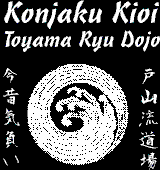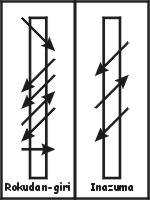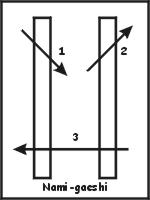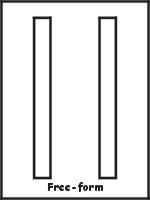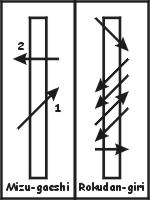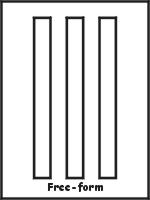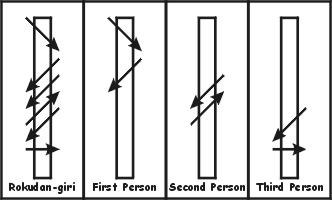 |
Toyama Ryu Batto Do Konjaku Kioi Dojo (Ancient and Modern Fighting Spirit Dojo) |
5980 66th St N Suite M St Petersburg FL 33709 Email: info@toyama-ryu.com Phone: 727-329-9679 |
|
Home
|
Taikai Rules and RegulationsThese guides are for students and instructors at the Konjaku Kioi dojo and any competitors in taikai sponsored by the dojo. All competitors and seminar participants are required to read and understand these rules. Failure to follow these rules may result in your expulsion from the seminars and tournament.
Tai Kai Rules - Etiquette
Tai Kai Rules - Equipment
Single Elimination TournamentKata, Tameshigiri, Wakizashi, and Team Tameshigiri are all multiple round single elimination competitions. Competitors are paired off for each round. From each pair, one person may advance to the next round. It is also possible for both competitors to be disqualified if both make serious mistakes. One competitor is assigned red and other is assigned white. Depending upon time limitation for the event, the competitors may perform simultaneously, or the white competitor will perform first. Both competitors should enter the competition area when called up. They should then bow to each other. They should also bow to the judges both before and after their performance. They should stand quietly and respectfully when not performing. The officiating team will have 3 or 5 judges. They will each raise a red or white flag to indicate the winner. They will raise both flags crossed to indicate that both competitors should been disqualified. The result of the round is the ruling of the majority of judges. The competitors should again bow to each other after the judgment and leave the competition floor. A competitor may be passed through the first round to create the proper number of competitor pairs. They may also be passed through a round if their prospective opponent was disqualified. This process continues until only two competitors remain undefeated. The final round puts these two against each other for 1st and 2nd place. The losers from the previous round face each other for 3rd and 4th place. The single elimination tournament may seem harsh to us. One mistake and you are out of the competition. It is not easy to deal with being eliminated in the first round. We must put the competition in the proper perspective of Japanese Swordsmanship. When two opponents face each other, only one moves on to the next fight. The winner is the last person standing. The judges may add an extra qualifying round to tameshigiri events. All competitors will perform the first round cutting sequence and get a pass/fail ruling from the judges. You must pass to qualify for the rest of the event. The competition will be set-up in the order in which competitors register. A competitor should not face a member of their dojo in the first round. A graphical representation showing each round in an event will be available. The competitors may be broken into two groups to facilitate a large event. Two panels of judges will be used until the final round is reached. Kata CompetitionThe Kata event is a single elimination competition (Single Elimination Description). There are three rank categories. Kyu ranks, Shodan , Nidan and above. Events for each rank will only be run if there are four or more competitors in that catagory. Each competitor will perform three kata per round. Any Japanese style kata may be performed but Toyama Ryu and Zen Nihon Batto-Do Renmei seitei kata are preferred. Katas performed must be Japanese-style (short and focused). Long, drawn out or fancy American kata are not permitted. Judges will base their decision on such aspects as timing, form, fluidity, effectiveness, attitude, and over-all presentation. Competitors should remember that they are judged the entire time they are on the competition floor and not just when they are performing kata. All aspects of the competition are subject to change by the head judges. Tameshigiri CompetitionThe Tameshigiri event is a single elimination competition (Single Elimination Description). There are three rank categories. Kyu ranks, Shodan , Nidan and above. Events for each rank will only be run if there are four or more competitors in that catagory. Each competitor will perform a series of cuts on one to three targets per round. The cuts are described below. A sequence of cuts may be started from the left or right. The targets will be single tatami mats. Judges will base their decision on such aspects as performing the proper sequence of cuts, angles of cuts, cleanness of cuts, and over-all presentation. Competitors may face disqualification for missing the target, not cutting all the way through a target, knocking the target off the stand, knocking over the stand, or hitting the peg in the top of the stand. The Judges may direct a competitor to stop and not continue if they have been disqualified. A competitor should never touch the target or stand. This includes adjusting the target or righting a stand that has been knocked over. Judges will penalize a competitor for not making cuts in the proper sequence, bad cutting angles, having a cut pass through a previous cut, having a cut pass through the top of the target, and shaving off too thin a piece of the target. Competitors are being judged for proper attitude and decorum the entire time they are on the competition floor. All aspects of the competition are subject to change by the head judges.
Free-form cuts on can be any series of cuts the competitor wishes to make. If multiple targets are used, the competitor may vary their spacing and arrangement. Multiple targets should be treated as if they represent multiple opponents. Wakizashi CompetitionThe Wakizashi Tameshigiri event is a single elimination competition (Single Elimination Description). Each competitor will perform a series of cuts on one target per round. The cuts are described below. A sequence of cuts may be started from the left or right. The targets will be single tatami mats. Judges will base their decision on such aspects as performing the proper sequence of cuts, angles of cuts, cleanness of cuts, and over-all presentation. Competitors may face disqualification for missing the target, not cutting all the way through a target, knocking the target off the stand, knocking over the stand, or hitting the peg in the top of the stand. The Judges may direct a competitor to stop and not continue if they have been disqualified. A competitor should never touch the target or stand. This includes adjusting the target or righting a stand that has been knocked over. Judges will penalize a competitor for not making cuts in the proper sequence, bad cutting angles, having a cut pass through a previous cut, having a cut pass through the top of the target, and shaving off too thin a piece of the target. Competitors are being judged for proper attitude and decorum the entire time they are on the competition floor. All aspects of the competition are subject to change by the head judges.
Free-form cuts on can be any series of cuts the competitor wishes to make. Dotan CompetitionThe Dotan event is a single round competition based on how many horizontal targets can be cut with a single vertical cut. The targets may be single or double tatami mats. The cut must be made at a 90-degree angle to the targets. Whole and fractional targets will be counted. Each competitor should advance to the dotan stand when directed by the Judges and then draw their sword. The targets may be touched ONCE with the sword to judge distance. If the target is touched more than once the competitor may be disqualified. After making a single cut, the competitor should remove their sword from the targets and back up about five steps before performing chuburi noto. If two competitors tie for one of the top places, they will both make another cut to determine their placement. All aspects of the competition are subject to change by the head judges. Team Tameshigiri CompetitionThe Team Tameshigiri event is a single elimination competition (Single Elimination Description). A team of 3 competitors will perform a rokudan-giri on one target per round. Each person must make two of the six cuts. A sequence of cuts may be started from the left or right, but must continue in the proper pattern. The targets will be single tatami mats until the final. The final will use double tatami mats. Judges will base their decision on such aspects as performing the proper sequence of cuts, angles of cuts, cleanness of cuts, and over-all presentation. Competitors may face disqualification for missing the target, not cutting all the way through a target, knocking the target off the stand, knocking over the stand, or hitting the peg in the top of the stand. The Judges may direct a competitor to stop and not continue if they have been disqualified. A competitor should never touch the target or stand. This includes adjusting the target or righting a stand that has been knocked over. Judges will penalize a competitor for not making cuts in the proper sequence, bad cutting angles, having a cut pass through a previous cut, having a cut pass through the top of the target, and shaving off too thin a piece of the target. Competitors are being judged for proper attitude and decorum the entire time they are on the competition floor. All aspects of the competition are subject to change by the head judge.
Tai Kai Rules - KumitachiKumitachi will NOT allow use of anything but Iaito. NO BOKEN / SHINKEN. Kumitachi is scored and is not an elimination event. Each pair of competitors will perform three Kumitachi. Kumitachi must be Japanese-style (short and focused). Long, drawn out or fancy American kumitachi are not permitted. Judges will base their decision on such aspects as timing, form, fluidity, effectiveness, attitude, and over-all presentation. Competitors should remember that they are judged the entire time they are on the competition floor and not just when they are performing kumitachi. All aspects of the competition are subject to change by the head judge. Tai Kai Rules - Miscellaneous
|
||||||||||||||||||||||||||||||||||||||||||||||||||
Copyright © 2006 by Konjaku Kioi Toyama Ryu Dojo, All rights reserved.
Samurai Swords
Iaito (Practice Swords)
Shinken (Cutting Swords)
Wakizashi (Short Swords)
Tanto (Daggers)
Japanese Weapons
Maintenance
Uniforms
Sharpening
Sword Repair
Martial Arts
Dictionary Your Name in Japanese
Dojo Stories
Tatami Targets
